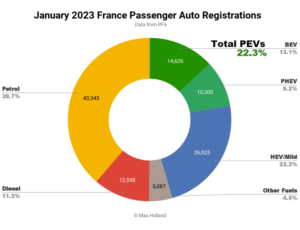Sign up for daily news updates from CleanTechnica on email. Or follow us on Google News!
What happens when shareholders aren’t happy with the likely trajectory of their company’s plans? The company opens up the wallets and lets the corporate cash flow. That’s what General Motors Co. (GM) and CEO Mary Barra did this week in response to critics who are unconvinced that the company’s future rests with electric vehicles (EVs) and autonomy.
GM is reinstating its full year 2023 earnings guidance after accounting for costs of its new labor contract. In addition, the company announced a $10 billion accelerated share repurchase (ASR) program and its intention to increase its common stock dividend by 33% beginning with the January, 2024 declaration.
The move seems to be working. Shares took flight up 12% to $32.29 shortly after the market opened in New York on Wednesday, countering a yearly trend of 14% reduction in value through Tuesday, compared with a 19% increase in the S&P 500 Index. Over the course of the week, GM price per share has risen nearly $4.00. Social sentiment for GM comes in at 86% bullish, with the sector average at 68%.
“The work has already begun,” Barra stated, “and I’m confident we will achieve our targets and grow from there.”
The total number of GM shares repurchased will be based upon final settlement and the daily volume-weighted average prices of GM common stock during the term of the program, which will conclude in the Q4, 2024. The repurchase program will be executed by Bank of America Corp., Goldman Sachs Group Inc., Barclays Bank PLC, and Citigroup Inc.
Of course, the elephant in the room is that GM and other legacy automakers are seeing short term profitability in its internal combustion engine (ICE) vehicles while the future for automakers lies with transportation electrification. Wasn’t it just back in July at the Aspen Ideas Institute that Barr explained how GM had decided to go electric?
“And so, when we looked at our plans and we looked at the regulatory environment, we thought the right thing to do was to get our entire portfolio from a light duty perspective to be all electric by 2035. That was a big statement. But when we did it, we mainly did it because we needed to get everybody internally in the company to stop debating when and start working on how to make sure we get it done.”
The Q3 2023 letter to shareholders took a different tone, describing the shifting GM plans for EVs.
“We are also moderating the acceleration of EV production in North America to protect our pricing, adjust to slower near-term growth in demand, and implement engineering efficiency and other improvements that will make our vehicles less expensive to produce, and more profitable.”
Yahoo! Finance interprets this move as more of a value play than a growth investment. Growth stocks hold promising positions in industry niches that depict long pathways for expansion ahead of them.
Many shareholders were skeptical that the company could be profitable after settling its labor negotiations. Transportation analyst Kevin Tynan wrote in Bloomberg Intelligence, “The move to offset the effects of higher costs from the new UAW contract adds confusion to GM’s electrification strategy and is out of step with the practice of conserving cash when demand is uncertain.” The highly publicized GM/ UAW contract, Barra explained, “rewards our team members but does not put our company and their jobs at risk.” GM is the first of the Detroit Three to reveal the costs from the new labor contract: about $575 a vehicle. She was also explicit that “jeopardizing our future is something I will not do.”
“We have confidence in the cash generation of this company,” Barra said on Bloomberg TV. “We’re demonstrating the confidence that we and the board have that we’re executing the strategy and we’re going to see growth and strong margins.”
Certainly, issues remain at GM. Interest rates make consumers hesitant to finance a new GM vehicle, whether EV or internal combustion engine (ICE). Barra wants to generate net profits at the same time GM transitions to more sophisticated technology. Capital expenditures from its EV expansion haven’t reached full effect yet. “We never thought that the EV adoption would necessarily be a straight line,” Barra admitted, yet she expects eventual “strong adoption” of EVs.
Getting GM’s battery plants at operating speed has been a particularly thorny subject. “We have a battery plant that is now running really well in Ohio,” Barra told Forbes in July. “We have another one in construction in Springfield, Tennessee. We have a third in Michigan, and then we just announced about a week ago that our fourth will be in Indiana.…It’s all new manufacturing.”
That newness under Barra has produced record profits but limited EV production to the the low thousands. Contrast that with Tesla, which has annual EV sales approaching 1.8 million vehicles. GM’s Ultium battery pack was promoted as a cure-all: various types of electric cars could be manufactured off the same platform. Barra indicates that the company’s electric battery and EV production issues should be fixed by mid-2024. And the company needs these problems to go away: EVs comprise a significant portion of GM’s strategy to double sales to $280 billion by 2030.
“Although I am disappointed with our Ultium-based EV production in 2023 due to difficulties with battery module assembly, we have made substantial improvements both to the process and to the organization responsible for this work,” Barra said in a shareholder letter. “In 2024, we expect significantly higher Ultium EV production and significantly improved EV margins.”
The debacle with Cruise hasn’t helped GM, either. The company’s fully automotive vehicle, or robotaxi, development was halted last month after one of its vehicles dragged a pedestrian for 20 feet. At Cruises’ $700 million a quarter, GM’s decision to garage the fleet hurt the company’s long term growth potential. Cruise is down to one city and is laying off workers. Instead, GM is emphasizing technology safety above all in Cruise’ continued development.
“We are finalizing a 2024 budget that will fully offset the incremental costs of our new labor agreements,” Barra concluded, “and the long-term plan we are executing includes reducing the capital intensity of the business, developing products even more efficiently, and further reducing our fixed and variable costs.” She added, “With this clear path forward, and our strong balance sheet, we will return significant capital to shareholders.”
Details of the GM earnings guidance include:
- Net income attributable to stockholders of $9.1 billion-$9.7 billion, compared to the previous outlook of $9.3 billion-$10.7 billion;
- EBIT-adjusted of $11.7 billion-$12.7 billion, compared to the previous outlook of $12.0 billion-$14.0 billion;
- EPS-diluted in the $6.52-$7.02 range, including the estimated impact of the ASR, compared to the previous outlook of $6.54-$7.54;
- EPS-diluted-adjusted in the $7.20-$7.70 range including the estimated impact of the ASR, compared to the previous outlook of $7.15-$8.15;
- Net automotive cash provided by operating activities of $19.5 billion-$21.0 billion, compared to the previous outlook of $17.4 billion-$20.4 billion; and,
- Adjusted automotive free cash flow of $10.5 billion-$11.5 billion, compared to the previous outlook of $7.0 billion-$9.0 billion.
Have a tip for CleanTechnica? Want to advertise? Want to suggest a guest for our CleanTech Talk podcast? Contact us here.
CleanTechnica Holiday Wish Book
Our Latest EVObsession Video
[embedded content]
I don’t like paywalls. You don’t like paywalls. Who likes paywalls? Here at CleanTechnica, we implemented a limited paywall for a while, but it always felt wrong — and it was always tough to decide what we should put behind there. In theory, your most exclusive and best content goes behind a paywall. But then fewer people read it!! So, we’ve decided to completely nix paywalls here at CleanTechnica. But…
Thank you!
Advertisement
CleanTechnica uses affiliate links. See our policy here.
- SEO Powered Content & PR Distribution. Get Amplified Today.
- PlatoData.Network Vertical Generative Ai. Empower Yourself. Access Here.
- PlatoAiStream. Web3 Intelligence. Knowledge Amplified. Access Here.
- PlatoESG. Carbon, CleanTech, Energy, Environment, Solar, Waste Management. Access Here.
- PlatoHealth. Biotech and Clinical Trials Intelligence. Access Here.
- Source: https://cleantechnica.com/2023/12/02/we-never-thought-that-ev-adoption-would-necessarily-be-a-straight-line-mary-barra/
- :has
- :is
- :not
- ][p
- $UP
- 1
- 15%
- 20
- 2023
- 2024
- 2030
- 29
- 36
- 500
- 54
- 7
- 70
- 8
- a
- About
- above
- accelerated
- acceleration
- Accounting
- Achieve
- activities
- added
- addition
- Adds
- adjust
- Adoption
- Advertise
- Affiliate
- After
- ago
- agreements
- ahead
- All
- already
- also
- always
- am
- america
- analyst
- and
- announced
- annual
- Another
- approaching
- ARE
- AS
- Assembly
- At
- automakers
- automotive
- Autonomy
- average
- away
- back
- Balance
- Balance Sheet
- Bank
- Bank of America
- Barclays
- Barclays Bank
- based
- battery
- BE
- because
- been
- Beginning
- begun
- behind
- BEST
- Big
- Billion
- Bit
- Bloomberg
- board
- book
- both
- budget
- Bullish
- business
- but
- by
- capital
- cars
- Cash
- cash flow
- ceo
- chip
- Citigroup
- City
- cleantech
- Cleantech Talk
- clear
- CO
- comes
- Common
- common stock
- Companies
- company
- Company’s
- compared
- completely
- conclude
- concluded
- confidence
- confident
- confusion
- construction
- Consumers
- content
- continued
- contract
- contrast
- Corp
- Corporate
- Costs
- could
- countering
- course
- cover
- Critics
- cruise
- daily
- debating
- decide
- decided
- decision
- Demand
- demonstrating
- describing
- detail
- developing
- Development
- DID
- different
- difficulties
- dividend
- do
- does
- don
- done
- double
- down
- due
- during
- Earnings
- effect
- effects
- efficiency
- efficiently
- either
- Electric
- electric cars
- electric vehicles
- elephant
- embedded
- emphasizing
- Engine
- Engineering
- Entire
- Environment
- estimated
- EV
- Even
- eventual
- everybody
- evs
- Exclusive
- executed
- executing
- expansion
- expect
- expects
- expensive
- explained
- Feet
- felt
- fewer
- final
- finance
- First
- fixed
- FLEET
- flight
- flow
- For
- Forbes
- Forward
- Fourth
- Free
- from
- full
- fully
- further
- future
- garage
- General
- General Motors
- generate
- generation
- get
- GM
- Go
- Goes
- going
- goldman
- Goldman Sachs
- Group
- Grow
- Growth
- growth potential
- Guest
- guidance
- had
- happens
- happy
- Have
- help
- helped
- here
- Hesitant
- higher
- highly
- hold
- Holiday
- How
- How To
- HTML
- HTTPS
- Hurt
- i
- ICE
- ideas
- if
- Impact
- implement
- implemented
- improved
- improvements
- in
- Inc.
- include
- includes
- Including
- Income
- Increase
- incremental
- index
- Indiana
- indicates
- industry
- instead
- Intention
- internal
- internally
- investment
- issues
- IT
- ITS
- January
- Jobs
- July
- just
- labor
- Last
- latest
- laying
- Legacy
- less
- Lets
- letter
- lies
- light
- like
- likely
- likes
- Limited
- Line
- links
- Long
- long-term
- looked
- Low
- made
- mainly
- make
- manufactured
- margins
- Market
- mary barra
- max-width
- Media
- Members
- Michigan
- million
- module
- Month
- more
- most
- Motors
- move
- nearly
- necessarily
- Need
- needed
- needs
- negotiations
- net
- never
- New
- New York
- news
- North
- north america
- now
- number
- of
- off
- offset
- Ohio
- on
- ONE
- opened
- opens
- operating
- or
- organization
- Other
- our
- Our Company
- out
- Outlook
- over
- Pack
- particularly
- path
- pathways
- People
- per
- perspective
- plan
- plans
- plant
- plants
- platform
- plato
- Plato Data Intelligence
- PlatoData
- Play
- player
- PLC
- podcast
- policy
- portfolio
- positions
- potential
- practice
- previous
- price
- Prices
- pricing
- problems
- process
- produce
- Produced
- Production
- Products
- profitability
- profitable
- profits
- Program
- promising
- Promoted
- protect
- provided
- publish
- put
- Q3
- Quarter
- range
- reached
- Read
- Reader
- really
- record
- reducing
- reduction
- regulatory
- remain
- response
- responsible
- return
- reveal
- right
- Risen
- Risk
- robotaxi
- Room
- running
- S&P
- S&P 500
- Sachs
- Safety
- Said
- sales
- same
- sector
- see
- seeing
- seems
- sentiment
- settlement
- settling
- Share
- shareholder
- Shareholders
- Shares
- she
- sheet
- SHIFTING
- Short
- Shortly
- should
- significant
- significantly
- skeptical
- So
- Social
- something
- sophisticated
- speed
- start
- stated
- Statement
- Step
- stock
- Stocks
- Stop
- Stories
- straight
- Strategy
- strong
- subject
- substantial
- suggest
- support
- sure
- T
- Talk
- targets
- team
- Team members
- Technology
- tennessee
- term
- Tesla
- than
- that
- The
- The Capital
- The Future
- their
- Them
- then
- theory
- There.
- These
- thing
- Third
- this
- this week
- thought
- thousands
- three
- Through
- time
- tip
- to
- TONE
- took
- Total
- tough
- trajectory
- transitions
- transportation
- Trend
- Tuesday
- types
- Uncertain
- under
- Updates
- upon
- us
- uses
- value
- variable
- various
- Ve
- vehicle
- Vehicles
- Video
- Wallets
- want
- wants
- was
- we
- Wednesday
- week
- WELL
- were
- What
- when
- whether
- which
- while
- WHO
- will
- with
- Work
- workers
- working
- would
- write
- Wrong
- Yahoo
- year
- yearly
- yet
- york
- you
- Your
- youtube
- zephyrnet






